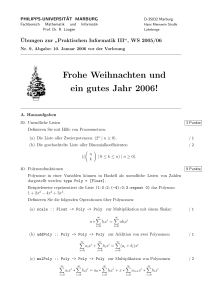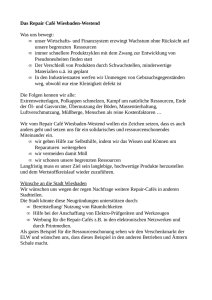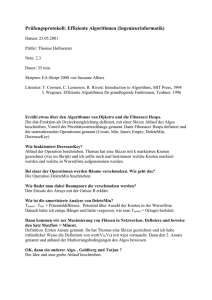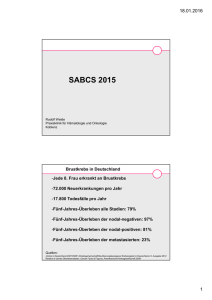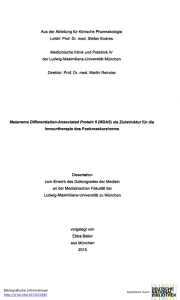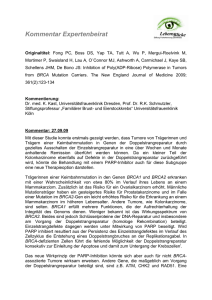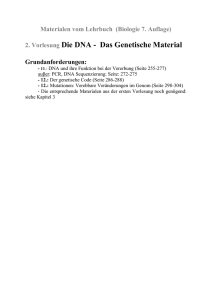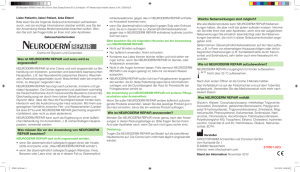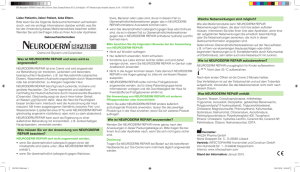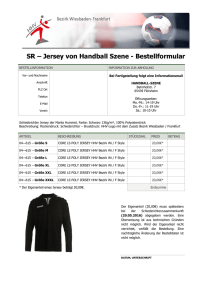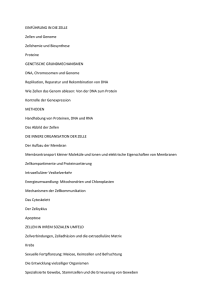The Role of Poly(ADP-Ribose) Formation - ETH E
Werbung
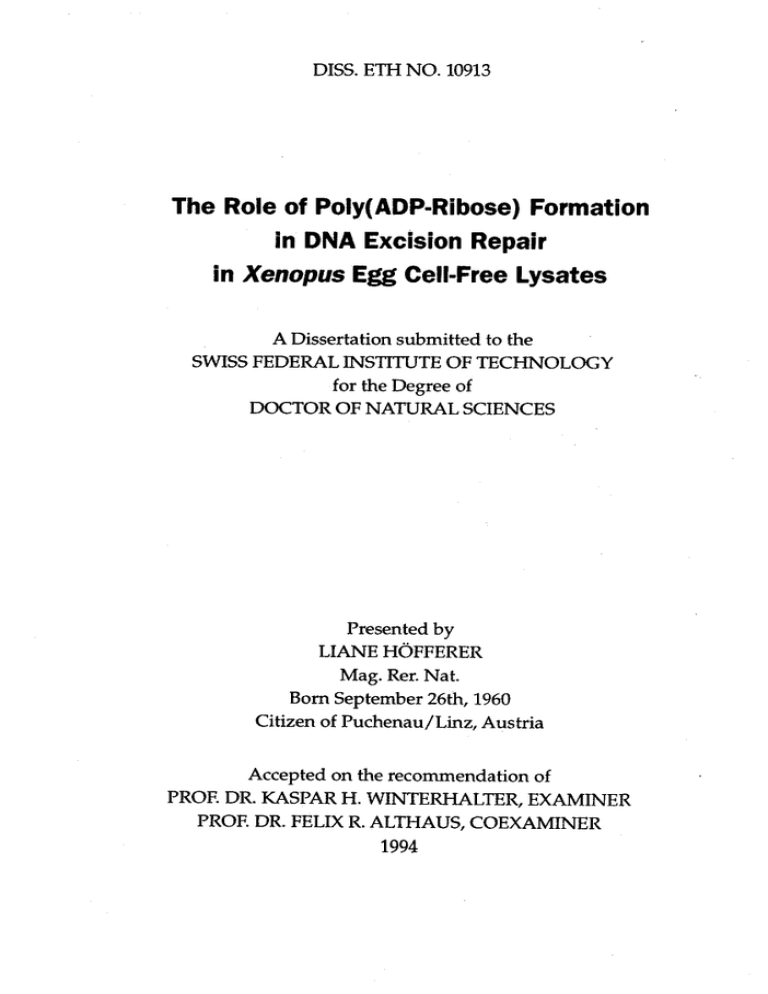
DISS. ETH NO. 10913 The Role of Poly(ADP-Ribose) Formation in DNA Excision in Xenopus Egg Repair Cell-Free Lysates A Dissertation submitted to the SWISS FEDERAL INSTITUTE OF TECHNOLOGY for the Degree of DOCTOR OF NATURAL SCIENCES Presented by LIANE HOFFERER Mag. Born Rer. Nat. September 26th, 1960 Puchenau/Linz, Austria Citizen of Accepted on the recommendation of PROF. DR. KASPAR H. PROF. DR. FELIX R. WINTERHALTER, EXAMINER ALTHAUS, COEXAMINER 1994 6 SUMMARY Poly(ADP-ribose) polymerase (PARP) catalizing a mainly on inhibitor studies, is versatile enzyme in the cell nucleus a highly energy consuming process. Experimental evidence, suggested essential function in DNA excision ribosyl)ation and AAF adducts repair. repair directly, in DNA established which is able to by that poly(ADP-ribose) turnover has To address the role of Xenopus a based an poly(ADP- laevis egg cell-free system was repair i) pyrimidine dimers, (6-4) photoproducts, nucleotide excision repair (NER), and ii) pyrimidine hydrates, alkylated thymine glycols by base excision repair (BER) with high efficiency. The main findings were that repair occurs via a distributive mode bases and and that the excision poly(ADP-ribosyl)ation system damages which thesized and are substrates for BER, prevention repair. Contrastingly, the and the presence of the These data suggest apparently not of differentially the repair of UV- and competitive repair involved in the two of OsO4-and poly(ADP-ribose) polymers polymer production led to MNNG- were syn¬ drastic inhibition of a AAF-damage did not activate PARP inhibitor benzamide did not affect NER. poly(ADP-ribosyl)ation is directly involved in BER but employed in NER in the Xenopus egg lysate system. However, the that involvment of PARP in BER appears to be binds is repair pathways investigated. During a negative one, in that the enzyme tightly to DNA strand breaks and competes with repair enzymes for access damaged site. Only upon automodification, PARP is released from DNA allowing access of repair enzymes. Xenopus lysates with inactivated PARP to the thus exhibit full DNA excision if PARP is dispensable emerging from It might nation processes and in integrity in DNA excision different groups ribose) function. the view that repair in the absence of poly(ADP-ribose) have repair, including ours a role in the sensoring poly-(ADP-ribose) DNA has a what is it led to a new prevention damage. of turnover. doing sight of poly(ADP- illegitimate General So, then? Data agreement recombi¬ exists in role in the maintenance of genome and chromatin metabolism. 115 7 ZUSAMMENFASSUNG Poly(ADP-ribose) polymerase (PARP) Die ist ein vielseitiges Enzym des Zell- kerns, welches einen energetisch aufwendigen Mechanismus katalysiert. Auf- grund experimenteller Daten, wurde vermutet, dafi ren, DNS vis Eiern vorwiegend Poly(ADP-ribose) Exzisions-Reparatur tragt. bei der DNS auf Poly(ADP-ribosyl)ierung ein zellfreies Lysat aus Xenoptis laehergestellt. Dieses konnte i) Pyrimidin-Dimere, (6-4) Photoschaden und Hydrate, alkylierte Nukleotid-Exzisions-Reparatur (NER) und ii) Pyrimidin Thymin Glykole iiber den Basen-Exzisions-Repa- Basen und (BER) Mechnismus mit hoher Effizienz reparieren. Resultate waren, dafi die erfolgt basie- Enzym-Hemmstudien eine essentielle Funktion bei der Um die Funktion der Reparatur zu studieren, wurde AAF-Addukte iiber den ratur die und dafi die Reparatur Die hervorstechendsten iiber einen distributiven Mechanismus Poly(ADP-ribosyl)ierung in den zwei untersuchten Reparabeteiligt ist. Wahrend der Reparatur von OSO4- und verschieden turwegen MNNG-Schaden, die iiber den BER Mechanismus erfolgen, wurden Poly(ADP- ribose) Polymere gebildet, und die Verhinderung der Polymer Synthese zu einer drastischen wahrend der der Hemmung Reparatur kompetitive Reparatur. UV- und AAF-Schaden PARP nicht aktiviert und dafi im Xenopus Ei Lysat System, Poly(ADP-ribosyl)- direkt in der BER aber offensichtlich nicht in der NER beteiligt noch erwies sich selbst die Funktion der PARP in der BER als eine indem das von pus Enzym den Zugang men der DNS Lysate ribose) fest an an DNS Strangbriiche bindet und somit ist. Den- negative, Reparaturenzy- die DNS behindert. Erst duch Automodifikation kann PARP abgehen und somit Zugang mit inaktivierter PARP Umsatz. Daraus Exzisions-Reparatur zellularen fuhrte Im Unterschied dazu wurde Inhibitor Benzamid hatte keinen EinfluG auf die NER. Diese Ergebnisse implizieren, ierung von der ergibt nicht Regeneration fur zeigten sich die Reparaturenzyme schaffen. voile Reparatur folgende Frage: benotigt wird, ohne Xeno¬ poly(ADP- "Wenn PARP fur DNS welche Funktion hat nach DNA es dann bei der aus verschieSchadigung?" Jiingste Gruppen, unsere eingeschlossen, fiihrten zu einer neuen Sicht, was die Funktion der Poly(ADP-ribose) betrifft. Es diirfte eine Rolle bei der Verhinde¬ Daten denen rung von Schaden illegitimen Rekombinationsprozessen und spielen. Einig ist man darin, daG Bewahrung der Genom-Integritat im Poly(ADP-ribose) Aufspiiren von DNS eine Funktion bei der und im Chromatin-Metabolismus spielt. 119

